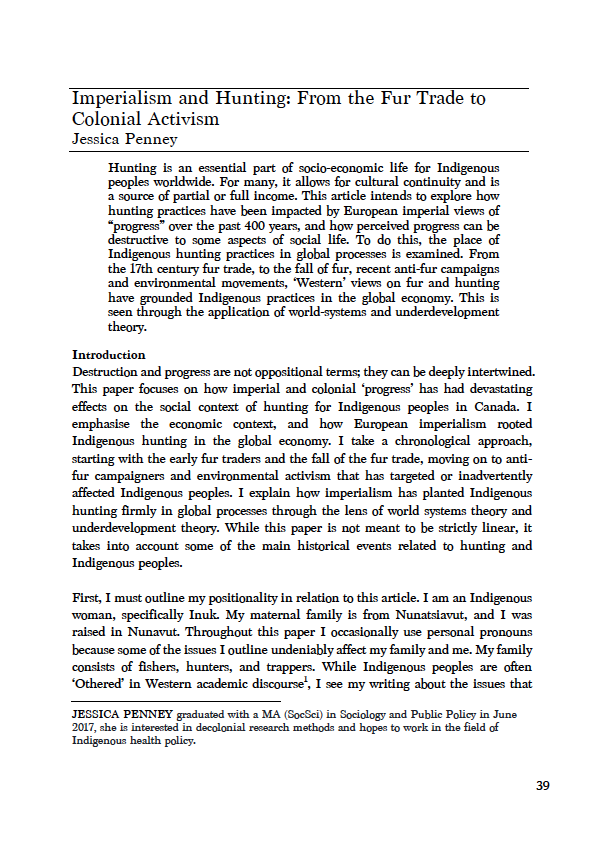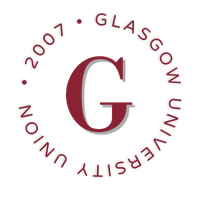Imperialism and Hunting
From the Fur Trade to Colonial Activism
DOI:
https://doi.org/10.36399/GroundingsUG.10.186Keywords:
Imperialism, Hunting, Fur trade, Indigenous, First Nations, Nunavut, InuitAbstract
Hunting is an essential part of socio-economic life for Indigenous peoples worldwide. For many, it allows for cultural continuity and is a source of partial or full income. This article intends to explore how hunting practices have been impacted by European imperial views of “progress” over the past 400 years, and how perceived progress can be destructive to some aspects of social life. To do this, the place of Indigenous hunting practices in global processes is examined. From the 17th century fur trade, to the fall of fur, recent anti-fur campaigns and environmental movements, ‘Western’ views on fur and hunting have grounded Indigenous practices in the global economy. This is seen through the application of world-systems and underdevelopment theory.
References
Arnaquq-Baril, A. 2016. ‘Angry Inuk’ argues anti-seal hunt campaign hurts Canadian Inuit life. Interviewed by Anna Maria Tremonti. [radio] CBC Radio. 4 May 2016.
Carlos, A.M. and Lewis, F.D. 1991. Property rights, competition, and depletion in the eighteenth century Canadian fur trade: the role of the European market. Canadian Journal of Economics. 32 (3).
Chan et al. 2006. Food Security in Nunavut, Canada: Barriers and Recommendations. International Journal of Circumpolar Health. 65 (5).
Condon, R.G., Collings, P. and Wenzel, G. 1995. The Best Part of Life: Subsistence Hunting, Ethnicity, and Economic Adaptation among Young Adult Inuit Males. Arctic. 48 (1).
De Tocqueville, A. n.d. Chapter 18: The Present and Probably Future Condition of the Three Races That Inhabit the Territory of the United States. [online] Available at: <http://xroads.virginia.edu/~hyper/detoc/1_ch18.htm> [Accessed 14 November 2016].
Emberley, J. 1998. Venus and Furs: the cultural politics of fur. London: L.B. Tauris & Co.
Feit, H.A. 2001. Hunting, Nature, and Metaphor: Political and Discursive Strategies in James Bay Cree Resistance and Autonomy. In: J.A. Grim, ed. 2001. Indigenous traditions and ecology: the interbeing of cosmology and community. Cambridge, Massachusetts: Harvard University Press.
Filho, C.S. 2015. Monopolies and Underdevelopment: From colonial past to global reality.Cheltenham: Edgar Elgar Publishing Limited.
Frey, G.W. and Linke, D.M. 2002. Hydropower as a renewable and sustainable energy resource meeting global energy challenges in a reasonable way. Energy Policy. 30(14).
Government of Northwest Territories. 2015. Trends in hunting and fishing in the NWT. [online] Available at: <http://www.enr.gov.nt.ca/state-environment/182-trends-hunting-and-fishingnwt> [Accessed 5 January 2017].
Hicks, J. 2015. Statistical data on death by suicide by Nunavut Inuit, 1920 to 2014. [online] Nunavut Tunngavik Inc. Available at: <http://www.tunngavik.com/files/2015/09/2015-09-14Statistical-Historical-Suicide-Date-Eng.pdf> [Accessed 21 December 2016].
Innis, H.A. 1930. The Fur Trade in Canada: An Introduction to Canadian Economic History. New Haven: Yale University Press.
Lee, D. and G.D. Wenzel. 2004. Narwhal Hunting by Pond Inlet Inuit: An Analysis of Foraging Mode in the Floe-Edge Environment. Inuit Studies. 28(2).
National Aboriginal Health Organization. 2016. Terminology. [online] Available at: <http://www.naho.ca/publications/topics/terminology/> [Accessed 23 December 2016].
National Aboriginal Health Organization. 2017. Overview of Inuit Health. [online] Available at:<http://www.naho.ca/inuit/overview-of-inuit-health/> [Accessed 5 January [2017].
Nunatsiavut Government. 2016. Lake Melville: Avativut, Kanuittailinnivut. Nain, Canada: Nunatsiavut Government.
Ray, A.J. 2005. Indians in the Fur Trade: Their role as trappers, hunters, and middlemen in the lands southwest of Hudson Bay, 1660-1870. Toronto: University of Toronto Press.
Ray, A.J. 2009. Hudson’s Bay Company. [online] Available at: http://www.thecanadianencyclopedia.ca/en/article/hudsons-bay-company/ [Accessed 14 November 2016].
Said, E. 2003. Orientalism. London: Penguin Books Ltd.
Smith, L. 2005. Decolonizing methodologies: research and Indigenous peoples. London: ZED Books.
Wachowich, N. 2001. Saqiyuq: stories from the lives of three Inuit women. Montreal & Kingston: McGill-Queen’s University Press.
Wallerstein, I. 2005. World-systems analysis: An introduction. Durham & London: Duke University Press.
Wenzel, G. 1987. “I Was Once Independent”: The Southern Seal Protest and Inuit. Anthropologica. 29(2).
Wenzel, G. 1991. Animal Rights, Human Rights: Ecology, economy and ideology in the Canadian Arctic. London: Bellhaven Press.
Wenzel, G.W. 1995. Ningiqtuq: Inuit Resource Sharing and Generalized Reciprocity in Clyde River, Nunavut. Arctic Anthropology. 32(2).
Young, L. 2000. Imperial Culture: The primitive, the savage and white civilization. In: L. Back and J. Solomos, eds. 2000. Theories of race and racism: a reader. London: Routledge.

Downloads
Published
Issue
Section
License
Copyright (c) 2017 Jessica Penney

This work is licensed under a Creative Commons Attribution 4.0 International License.
The CC BY 4.0 license is a Creative Commons license. This is a non-copyleft free license that is good for art and entertainment works, and educational works. It is compatible with all versions of the GNU GPL; however, like all CC licenses, it should not be used on software. People are free to: Share — copy and redistribute the material in any medium or format; Adapt — remix, transform, and build upon the material for any purpose, even commercially. The licensor cannot revoke these freedoms as long as you follow the license terms. But they must conform to the following terms: Attribution — You must give appropriate credit, provide a link to the license, and indicate if changes were made. You may do so in any reasonable manner, but not in any way that suggests the licensor endorses you or your use. No additional restrictions — You may not apply legal terms or technological measures that legally restrict others from doing anything the license permits.
Please check individual article PDF copies to see if any additional restrictions apply.







